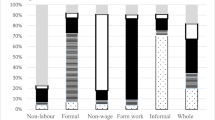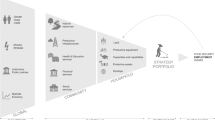Abstract
Research on the association between rural households’ livelihood capitals and livelihood strategies has long been of interest in geography, management, economics, ecology and other disciplines. However, the existing micro-empirical studies are mostly small-scale surveys of rural households; there are much fewer large-scale investigations at the national level. Meanwhile, few empirical studies have analyzed the sensitivity of rural households’ livelihood strategies to various types of livelihood capitals in different types of villages, from the perspective of village type. This study uses survey data from 8031 rural households in 226 villages from 27 provinces (cities) of China; the villages were divided into three types: plain villages, hilly villages and mountainous villages. The livelihood capitals and livelihood strategies of rural households in different types of villages were examined, and ordinal logistic regression models were construed to explore the sensitivity of rural households’ livelihood strategies to various types of livelihood capitals in different types of villages. The results revealed that: (1) the sample of rural households had similar livelihood asset structures and livelihood strategy selections across the different types of villages. Among them, human capital was the most important livelihood asset for rural households, while rural households had the lowest dependence on natural capital; off-farm work was the main livelihood strategy for rural households, followed by on-farm work, while the proportion of households engaged in part-time work was the smallest. (2) Rural households’ livelihood strategies had different sensitivities to various types of livelihood capitals, and there were also differences in the sensitivities among different types of villages. For the total sample, as well as the hill and mountain village sub-samples, human and financial capitals had significant positive impacts on livelihood strategy, while nature and social capitals had significant negative impacts on livelihood strategy; physical capital had no significant impact on livelihood strategy. For the plain village sub-sample, human and physical capitals had significant positive impacts on livelihood strategy, while nature capital had a significant negative impact on livelihood strategy; financial and social capitals had no significant impacts on livelihood strategy. This study enhances our understanding of the characteristics of rural households’ livelihood capital structures and livelihood strategy selections as well as the sensitivity of rural households’ livelihood strategies to various types of livelihood capitals among different types of villages in China. These findings provide reference for the formulation of policies related to the improvement of rural households’ livelihoods in different types of villages.



Similar content being viewed by others
References
Babulo, B., Muys, B., Nega, F., Tollens, E., Nyssen, J., Deckers, J., et al. (2008). Household livelihood strategies and forest dependence in the highlands of Tigray. Northern Ethiopia. Agricultural Systems, 98(2), 147–155. https://doi.org/10.1016/j.agsy.2008.06.001.
Barrett, C. B., Reardon, T., & Webb, P. (2001). Nonfarm income diversification and household livelihood strategies in rural Africa: Concepts, dynamics, and policy implications. Food Policy, 26(4), 315–331. https://doi.org/10.1016/S0306-9192(01)00014-8.
Bebbington, A. (1999). Capitals and capabilities: A framework for analyzing peasant viability, rural livelihoods and poverty. World Development, 27(12), 2021–2044. https://doi.org/10.1016/S0305-750X(99)00104-7.
Cao, M., Xu, D., Xie, F., Liu, E., & Liu, S. (2016). The influence factors analysis of households’ poverty vulnerability in southwest ethnic areas of China based on the hierarchical linear model: A case study of Liangshan Yi autonomous prefecture. Applied Geography, 66(8229), 144–152. https://doi.org/10.1016/j.apgeog.2015.11.016.
Chambers, R., & Conway, G. R. (1992). Sustainable rural livelihoods: practical concepts for the 21st century. IDS Discussion Paper No. 296. Brighton, Institute of Development Studies.
Cherni, J. A., & Hill, Y. (2009). Energy and policy providing for sustainable rural livelihoods in remote locations: The case of Cuba. Geoforum, 40(4), 645–654. https://doi.org/10.1016/j.geoforum.2009.04.001.
Coomes, O. T., Barham, B. L., & Takasaki, Y. (2004). Targeting conservation–development initiatives in tropical forests: Insights from analyses of rain forest use and economic reliance among Amazonian peasants. Ecological Economics, 51(1), 47–64. https://doi.org/10.1016/j.ecolecon.2004.04.004.
Davd, R. S., Ann, G., Kate, M., & Karen, Z. (2001). Livelihood diversification in Uganda: Patterns and determinants of change across two rural districts. Food Policy, 26(4), 421–435. https://doi.org/10.1016/S0306-9192(01)00012-4.
Deng, X., Xu, D. D., Qi, Y. B., & Zeng, M. (2018a). Labor off-farm employment and cropland abandonment in rural china: Spatial distribution and empirical analysis. International Journal of Environmental Research and Public Health, 15(9), 1808–1824. https://doi.org/10.3390/ijerph15091808.
Deng, X., Xu, D. D., Zeng, M., & Qi, Y. B. (2018b). Landslides and cropland abandonment in China’s mountainous areas: Spatial distribution, empirical analysis and policy implications. Sustainability, 10(11), 3909–3925. https://doi.org/10.3390/su10113909.
DFID. (1999). Sustainable livelihood guidance sheets. London
Donohue, C., & Biggs, E. (2015). Monitoring socio-environmental change for sustainable development: Developing a multidimensional livelihoods index (MLI). Applied Geography, 62, 391–403. https://doi.org/10.1016/j.apgeog.2015.05.006.
Drinkwater, M., & Rusinow, T. (1999). Application of care’s livelihoods approach. Geneva: Care International.
Ellis, F. (2000). Rural livelihoods and diversity in developing countries. New York: Oxford University Press.
Erenstein, O., Hellin, J., & Chandna, P. (2010). Poverty mapping based on livelihood assets: a meso-level application in the Indo-Gangetic plains, India. Applied Geography, 30(1), 112–125. https://doi.org/10.1016/j.apgeog.2009.05.001.
Fang, Y. P., Fan, J., Shen, M. Y., & Song, M. Q. (2014). Sensitivity of livelihood strategy to livelihood capital in mountain areas: Empirical analysis based on different settlements in the upper reaches of the Minjiang River, China. Ecological Indicators, 38, 225–235. https://doi.org/10.1016/j.ecolind.2013.11.007.
Freduah, G., Fidelman, P., & Smith, T. F. (2017). The impacts of environmental and socio-economic stressors on small scale fisheries and livelihoods of fishers in Ghana. Applied Geography, 89, 1–11. https://doi.org/10.1016/j.apgeog.2017.09.009.
Gautam, Y., & Andersen, P. (2016). Rural livelihood diversification and household well-being: Insights from Humla, Nepal. Journal of Rural Studies, 44, 239–249. https://doi.org/10.1016/j.jrurstud.2016.02.001.
Guo, S., Liu, S., Peng, L., & Wang, H. (2014). The impact of severe natural disasters on the livelihoods of farmers in mountainous areas: A case study of Qingping township, Mianzhu city. Natural Hazards, 73(3), 1679–1696. https://doi.org/10.1007/s11069-014-1165-9.
Halloran, A., Roos, N., & Hanboonsong, Y. (2017). Cricket farming as a livelihood strategy in Thailand. Geographical Journal. https://doi.org/10.1111/geoj.12184.
Huang, X., Huang, X., He, Y., & Yang, X. (2017). Assessment of livelihood vulnerability of land-lost farmers in urban fringes: a case study of Xi’an, China. Habitat International, 59, 1–9. https://doi.org/10.1016/j.habitatint.2016.11.001.
Iorio, M., & Corsale, A. (2010). Rural tourism and livelihood strategies in Romania. Journal of Rural Studies, 26(2), 152–162. https://doi.org/10.1016/j.jrurstud.2009.10.006.
Liu, Z., Chen, Q., & Xie, H. (2018). Influence of the farmer’s livelihood assets on livelihood strategies in the western mountainous area, China. Sustainability, 10, 875–887. https://doi.org/10.3390/su10030875.
Liu, Y., & Li, Y. (2017). Revitalize the world’s countryside. Nature, 548(7667), 275–277. https://doi.org/10.1038/548275a.
Liu, Z., & Liu, L. (2016). Characteristics and driving factors of rural livelihood transition in the east coastal region of China: A case study of suburban Shanghai. Journal of Rural Studies, 43(14), 145–158. https://doi.org/10.1016/j.jrurstud.2015.12.008.
Liu, Y., & Xu, Y. (2016). A geographic identification of multidimensional poverty in rural China under the framework of sustainable livelihoods analysis. Applied Geography, 73(73), 62–76. https://doi.org/10.1016/j.apgeog.2016.06.004.
Long, H., & Liu, Y. (2016). Rural restructuring in China. Journal of Rural Studies, 47(47), 387–391. https://doi.org/10.1016/j.jrurstud.2016.07.028.
Martin, S. M., & Kai, L. (2016). Livelihood diversification in rural Laos. World Development, 83, 231–243. https://doi.org/10.1016/j.worlddev.2016.01.018.
Masud, M. M., Kari, F., Yahaya, S. R. B., & Al-Amin, A. Q. (2016). Livelihood assets and vulnerability context of marine park community development in Malaysia. Social Indicators Research, 125(3), 771–792. https://doi.org/10.1007/s11205-015-0872-2.
Peng, L., Liu, S., & Sun, L. (2016). Spatial–temporal changes of rurality driven by urbanization and industrialization: A case study of the Three Gorges Reservoir Area in Chongqing, China. Habitat International, 51, 124–132. https://doi.org/10.1016/j.habitatint.2015.10.021.
Peng, L., Xu, D. D., & Wang, X. X. (2018). Vulnerability of rural household livelihood to climate variability and adaptive strategies in landslide-threatened western mountainous regions of the Three Gorges Reservoir Area, China. Climate and Development. https://doi.org/10.1080/17565529.2018.1445613.
Rahman, H. M. T., Robinson, B. E., Ford, J. D., & Hickey, G. M. (2018). How do capital asset interactions affect livelihood sensitivity to climatic stresses? Insights from the northeastern floodplains of Bangladesh. Ecological Economics, 150, 165–176. https://doi.org/10.1016/j.ecolecon.2018.04.006.
Rigg, J., Salamanca, A., Phongsiri, M., & Sripun, M. (2017). More farmers, less farming? Understanding the truncated agrarian transition in Thailand. World Development, 107, 327–337. https://doi.org/10.1016/j.worlddev.2018.03.008.
Rigg, J., Salamanca, A., & Thompson, E. C. (2016). The puzzle of East and Southeast Asia’s persistent smallholder. Journal of Rural Studies, 43, 118–133. https://doi.org/10.1016/j.jrurstud.2015.11.003.
Scoones, I. (1998). Sustainable rural livelihoods: A framework for analysis, IDS Working Paper 72. Brighton: Institute of Development Studies.
Scoones, I. (2009). Livelihoods perspectives and rural development. The Journal of Peasant Studies, 36, 171–196. https://doi.org/10.1080/03066150902820503.
Sharp, K. (2003). Measuring destitution: integrating qualitative and quantitative approaches in the analysis of survey data. IDS working paper.
Shirai, Y., Fox, J., Leisz, S. J., Fukui, H., & Rambo, A. T. (2017). The influence of local non-farm employment on rural household structure in northeast Thailand. Journal of Rural Studies, 54, 52–59. https://doi.org/10.1016/j.jrurstud.2017.06.003.
Shirai, Y., & Rambo, A. T. (2017). Household structure and sources of income in a rice-growing village in northeast Thailand. Southeast Asian Studies, 6(62), 275–292. https://doi.org/10.20495/seas.6.2_275.
Singh, R. K., Zander, K. K., Kumar, S., Singh, A., Sheoran, P., Kumar, A., et al. (2017). Perceptions of climate variability and livelihood adaptations relating to gender and wealth among the Adi, community of the Eastern Indian Himalayas. Applied Geography, 86, 41–52. https://doi.org/10.1016/j.apgeog.2017.06.018.
Soltani, A., Angelsen, A., Eid, T., Naieni, M. S. N., & Shamekhi, T. (2012). Poverty, sustainability, and household livelihood strategies in Zagros, Iran. Ecological Economics, 79(4), 60–70. https://doi.org/10.1016/j.ecolecon.2012.04.019.
Su, F., Saikia, U., & Hay, L. (2018). Relationships between livelihood risks and livelihood capitals: A case study in Shiyang River Basin, China. Sustainability, 10(2), 509–528. https://doi.org/10.3390/su10020509.
Wan, J., Deng, W., Song, X., Liu, Y., Zhang, S., Su, Y., et al. (2018). Spatio-temporal impact of rural livelihood capital on labor migration in Panxi, southwestern mountainous region of China. Chinese Geographical Science, 28(1), 153–166. https://doi.org/10.1007/s11769-018-0936-8.
Xu, D. D., Cao, S., Wang, X. X., & Liu, S. Q. (2018a). Influences of labor migration on rural household land transfer: A case study of Sichuan Province, China. Journal of Mountain Science, 15, 2055–2067. https://doi.org/10.1007/s11629-018-4973-7.
Xu, D. D., Guo, S. L., Xie, F. T., Liu, S. Q., & Cao, S. (2017a). The impact of rural laborer migration and household structure on household land use arrangements in mountainous areas of Sichuan Province, China. Habitat International, 70, 72–80. https://doi.org/10.1016/j.habitatint.2017.10.009.
Xu, D. D., Liu, E. L., Wang, X. X., Tang, H., & Liu, S. Q. (2018b). Rural households’ livelihood capital, risk perception, and willingness to purchase earthquake disaster insurance: Evidence from Southwestern China. International Journal of Environmental Research and Public Health, 15, 1319–1338. https://doi.org/10.3390/ijerph15071319.
Xu, D. D., Peng, L., Liu, S. Q., Su, C. J., Wang, X. X., & Chen, T. T. (2017b). Influences of migrant work income on the poverty vulnerability disaster threatened area: A case study of the Three Gorges Reservoir area, China. International Journal of Disaster Risk Reduction, 22, 62–70. https://doi.org/10.1016/j.ijdrr.2017.03.001.
Xu, D. D., Zhang, J. F., Rasul, G., Liu, S. Q., Xie, F. T., Cao, M. T., et al. (2015). Household livelihood strategies and dependence on agriculture in the mountainous settlements in the Three Gorges reservoir area, China. Sustainability, 7, 4850–4869. https://doi.org/10.3390/su7054850.
Acknowledgements
We gratefully acknowledge financial supports from the National Natural Science Foundation of China (Grant Nos. 41801221; 41571527; 41601614; 41701622), the Sichuan Center for Rural Development Research Project (No. 01781912), and the Ministry of Education Humanities and Social Science Research Youth Fund Project (No. 17YJC630136). The authors also extend great gratitude to the anonymous reviewers and editors for their helpful review and critical comments. Additionally, all authors are very grateful to the Center for Social Science Survey at Sun Yat-sen University who provides the data.
Author information
Authors and Affiliations
Corresponding author
Rights and permissions
About this article
Cite this article
Xu, D., Deng, X., Guo, S. et al. Sensitivity of Livelihood Strategy to Livelihood Capital: An Empirical Investigation Using Nationally Representative Survey Data from Rural China. Soc Indic Res 144, 113–131 (2019). https://doi.org/10.1007/s11205-018-2037-6
Accepted:
Published:
Issue Date:
DOI: https://doi.org/10.1007/s11205-018-2037-6




